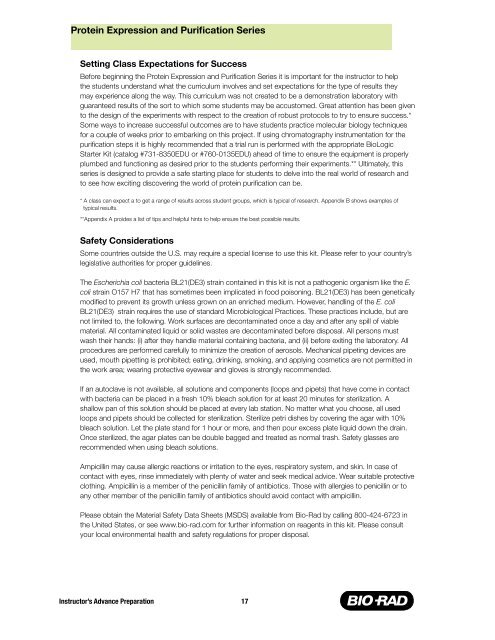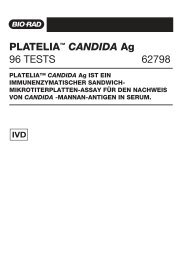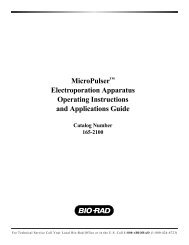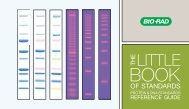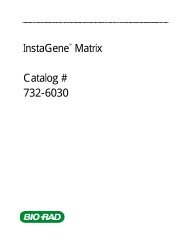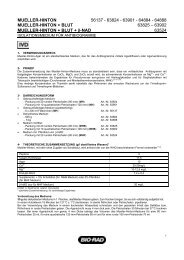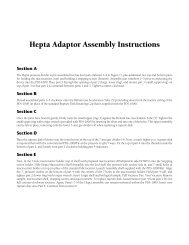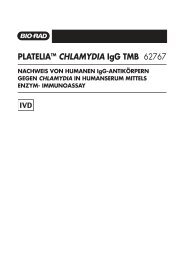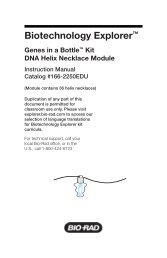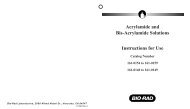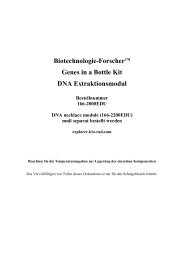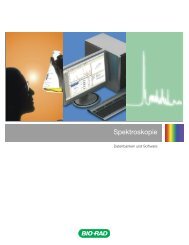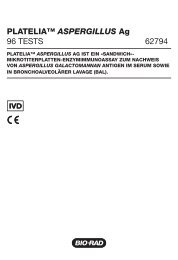Protein Expression and Purification Series - Bio-Rad
Protein Expression and Purification Series - Bio-Rad
Protein Expression and Purification Series - Bio-Rad
You also want an ePaper? Increase the reach of your titles
YUMPU automatically turns print PDFs into web optimized ePapers that Google loves.
<strong>Protein</strong> <strong>Expression</strong> <strong>and</strong> <strong>Purification</strong> <strong>Series</strong><br />
Setting Class Expectations for Success<br />
Before beginning the <strong>Protein</strong> <strong>Expression</strong> <strong>and</strong> <strong>Purification</strong> <strong>Series</strong> it is important for the instructor to help<br />
the students underst<strong>and</strong> what the curriculum involves <strong>and</strong> set expectations for the type of results they<br />
may experience along the way. This curriculum was not created to be a demonstration laboratory with<br />
guaranteed results of the sort to which some students may be accustomed. Great attention has been given<br />
to the design of the experiments with respect to the creation of robust protocols to try to ensure success.*<br />
Some ways to increase successful outcomes are to have students practice molecular biology techniques<br />
for a couple of weeks prior to embarking on this project. If using chromatography instrumentation for the<br />
purification steps it is highly recommended that a trial run is performed with the appropriate <strong>Bio</strong>Logic<br />
Starter Kit (catalog #731-8350EDU or #760-0135EDU) ahead of time to ensure the equipment is properly<br />
plumbed <strong>and</strong> functioning as desired prior to the students performing their experiments.** Ultimately, this<br />
series is designed to provide a safe starting place for students to delve into the real world of research <strong>and</strong><br />
to see how exciting discovering the world of protein purification can be.<br />
* A class can expect a to get a range of results across student groups, which is typical of research. Appendix B shows examples of<br />
typical results.<br />
**Appendix A proides a list of tips <strong>and</strong> helpful hints to help ensure the best possible results.<br />
Safety Considerations<br />
Some countries outside the U.S. may require a special license to use this kit. Please refer to your country’s<br />
legislative authorities for proper guidelines.<br />
The Escherichia coli bacteria BL21(DE3) strain contained in this kit is not a pathogenic organism like the E.<br />
coli strain O157 H7 that has sometimes been implicated in food poisoning. BL21(DE3) has been genetically<br />
modified to prevent its growth unless grown on an enriched medium. However, h<strong>and</strong>ling of the E. coli<br />
BL21(DE3) strain requires the use of st<strong>and</strong>ard Microbiological Practices. These practices include, but are<br />
not limited to, the following. Work surfaces are decontaminated once a day <strong>and</strong> after any spill of viable<br />
material. All contaminated liquid or solid wastes are decontaminated before disposal. All persons must<br />
wash their h<strong>and</strong>s: (i) after they h<strong>and</strong>le material containing bacteria, <strong>and</strong> (ii) before exiting the laboratory. All<br />
procedures are performed carefully to minimize the creation of aerosols. Mechanical pipeting devices are<br />
used, mouth pipetting is prohibited; eating, drinking, smoking, <strong>and</strong> applying cosmetics are not permitted in<br />
the work area; wearing protective eyewear <strong>and</strong> gloves is strongly recommended.<br />
If an autoclave is not available, all solutions <strong>and</strong> components (loops <strong>and</strong> pipets) that have come in contact<br />
with bacteria can be placed in a fresh 10% bleach solution for at least 20 minutes for sterilization. A<br />
shallow pan of this solution should be placed at every lab station. No matter what you choose, all used<br />
loops <strong>and</strong> pipets should be collected for sterilization. Sterilize petri dishes by covering the agar with 10%<br />
bleach solution. Let the plate st<strong>and</strong> for 1 hour or more, <strong>and</strong> then pour excess plate liquid down the drain.<br />
Once sterilized, the agar plates can be double bagged <strong>and</strong> treated as normal trash. Safety glasses are<br />
recommended when using bleach solutions.<br />
Ampicillin may cause allergic reactions or irritation to the eyes, respiratory system, <strong>and</strong> skin. In case of<br />
contact with eyes, rinse immediately with plenty of water <strong>and</strong> seek medical advice. Wear suitable protective<br />
clothing. Ampicillin is a member of the penicillin family of antibiotics. Those with allergies to penicillin or to<br />
any other member of the penicillin family of antibiotics should avoid contact with ampicillin.<br />
Please obtain the Material Safety Data Sheets (MSDS) available from <strong>Bio</strong>-<strong>Rad</strong> by calling 800-424-6723 in<br />
the United States, or see www.bio-rad.com for further information on reagents in this kit. Please consult<br />
your local environmental health <strong>and</strong> safety regulations for proper disposal.<br />
Instructor’s Advance Preparation<br />
17


